Innovation in Construction Practice - Benefits, Challenges, and Tools
VerifiedAdded on 2023/06/10
|11
|2306
|212
AI Summary
This article discusses the potential benefits and challenges of construction robotics, GPS tracking, and BIM tools in construction practice. It also explores internal innovation means and challenges faced by companies. The article covers the purpose, content, and stage of BIM delivery cycle for BIM grading tool and BIM capability tool. Subject: Construction Practice, Course Code: NA, Course Name: NA, College/University: NA
Contribute Materials
Your contribution can guide someone’s learning journey. Share your
documents today.
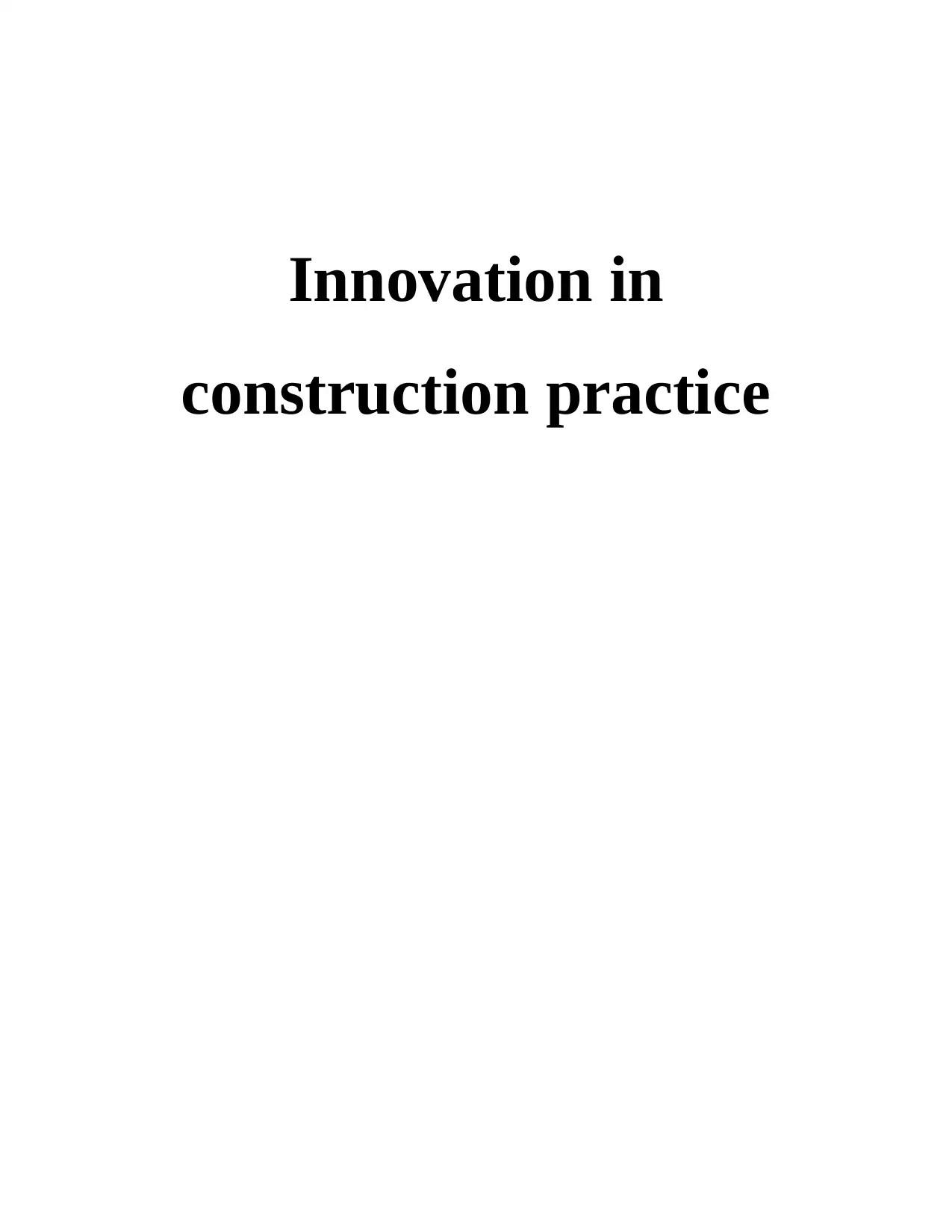
Innovation in
construction practice
construction practice
Secure Best Marks with AI Grader
Need help grading? Try our AI Grader for instant feedback on your assignments.

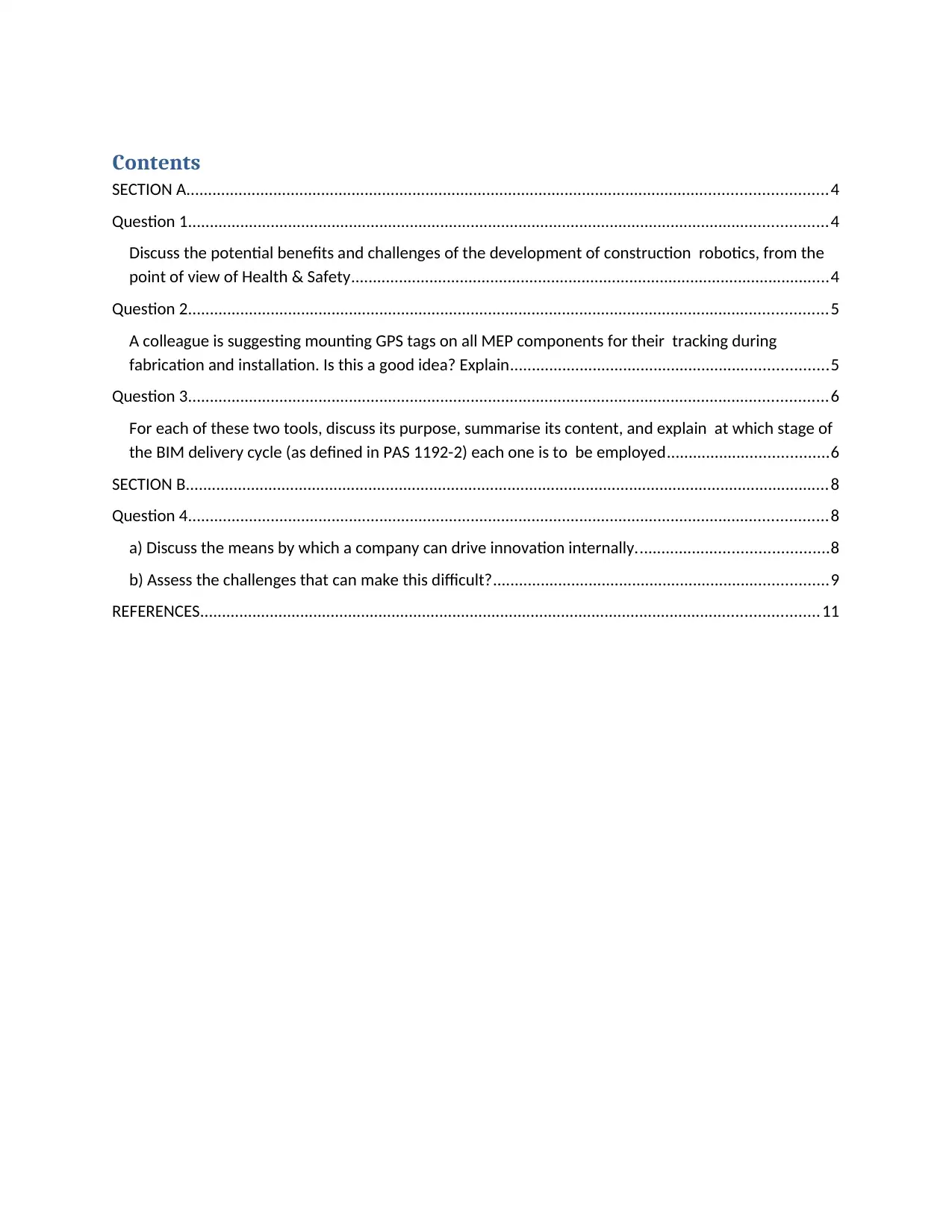
Contents
SECTION A...................................................................................................................................................4
Question 1...................................................................................................................................................4
Discuss the potential benefits and challenges of the development of construction robotics, from the
point of view of Health & Safety..............................................................................................................4
Question 2...................................................................................................................................................5
A colleague is suggesting mounting GPS tags on all MEP components for their tracking during
fabrication and installation. Is this a good idea? Explain.........................................................................5
Question 3...................................................................................................................................................6
For each of these two tools, discuss its purpose, summarise its content, and explain at which stage of
the BIM delivery cycle (as defined in PAS 1192-2) each one is to be employed.....................................6
SECTION B....................................................................................................................................................8
Question 4...................................................................................................................................................8
a) Discuss the means by which a company can drive innovation internally............................................8
b) Assess the challenges that can make this difficult?.............................................................................9
REFERENCES..............................................................................................................................................11
SECTION A...................................................................................................................................................4
Question 1...................................................................................................................................................4
Discuss the potential benefits and challenges of the development of construction robotics, from the
point of view of Health & Safety..............................................................................................................4
Question 2...................................................................................................................................................5
A colleague is suggesting mounting GPS tags on all MEP components for their tracking during
fabrication and installation. Is this a good idea? Explain.........................................................................5
Question 3...................................................................................................................................................6
For each of these two tools, discuss its purpose, summarise its content, and explain at which stage of
the BIM delivery cycle (as defined in PAS 1192-2) each one is to be employed.....................................6
SECTION B....................................................................................................................................................8
Question 4...................................................................................................................................................8
a) Discuss the means by which a company can drive innovation internally............................................8
b) Assess the challenges that can make this difficult?.............................................................................9
REFERENCES..............................................................................................................................................11
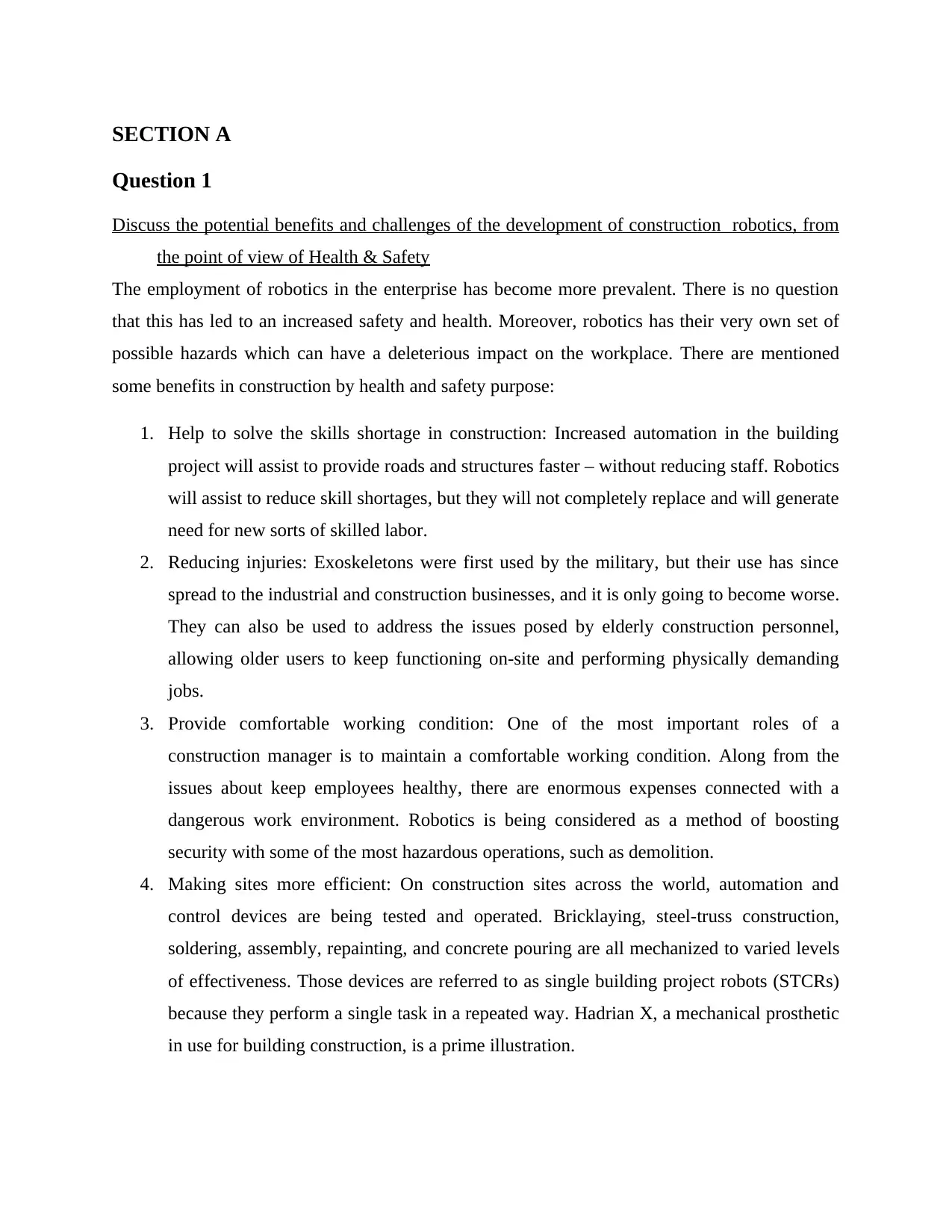
SECTION A
Question 1
Discuss the potential benefits and challenges of the development of construction robotics, from
the point of view of Health & Safety
The employment of robotics in the enterprise has become more prevalent. There is no question
that this has led to an increased safety and health. Moreover, robotics has their very own set of
possible hazards which can have a deleterious impact on the workplace. There are mentioned
some benefits in construction by health and safety purpose:
1. Help to solve the skills shortage in construction: Increased automation in the building
project will assist to provide roads and structures faster – without reducing staff. Robotics
will assist to reduce skill shortages, but they will not completely replace and will generate
need for new sorts of skilled labor.
2. Reducing injuries: Exoskeletons were first used by the military, but their use has since
spread to the industrial and construction businesses, and it is only going to become worse.
They can also be used to address the issues posed by elderly construction personnel,
allowing older users to keep functioning on-site and performing physically demanding
jobs.
3. Provide comfortable working condition: One of the most important roles of a
construction manager is to maintain a comfortable working condition. Along from the
issues about keep employees healthy, there are enormous expenses connected with a
dangerous work environment. Robotics is being considered as a method of boosting
security with some of the most hazardous operations, such as demolition.
4. Making sites more efficient: On construction sites across the world, automation and
control devices are being tested and operated. Bricklaying, steel-truss construction,
soldering, assembly, repainting, and concrete pouring are all mechanized to varied levels
of effectiveness. Those devices are referred to as single building project robots (STCRs)
because they perform a single task in a repeated way. Hadrian X, a mechanical prosthetic
in use for building construction, is a prime illustration.
Question 1
Discuss the potential benefits and challenges of the development of construction robotics, from
the point of view of Health & Safety
The employment of robotics in the enterprise has become more prevalent. There is no question
that this has led to an increased safety and health. Moreover, robotics has their very own set of
possible hazards which can have a deleterious impact on the workplace. There are mentioned
some benefits in construction by health and safety purpose:
1. Help to solve the skills shortage in construction: Increased automation in the building
project will assist to provide roads and structures faster – without reducing staff. Robotics
will assist to reduce skill shortages, but they will not completely replace and will generate
need for new sorts of skilled labor.
2. Reducing injuries: Exoskeletons were first used by the military, but their use has since
spread to the industrial and construction businesses, and it is only going to become worse.
They can also be used to address the issues posed by elderly construction personnel,
allowing older users to keep functioning on-site and performing physically demanding
jobs.
3. Provide comfortable working condition: One of the most important roles of a
construction manager is to maintain a comfortable working condition. Along from the
issues about keep employees healthy, there are enormous expenses connected with a
dangerous work environment. Robotics is being considered as a method of boosting
security with some of the most hazardous operations, such as demolition.
4. Making sites more efficient: On construction sites across the world, automation and
control devices are being tested and operated. Bricklaying, steel-truss construction,
soldering, assembly, repainting, and concrete pouring are all mechanized to varied levels
of effectiveness. Those devices are referred to as single building project robots (STCRs)
because they perform a single task in a repeated way. Hadrian X, a mechanical prosthetic
in use for building construction, is a prime illustration.
Secure Best Marks with AI Grader
Need help grading? Try our AI Grader for instant feedback on your assignments.
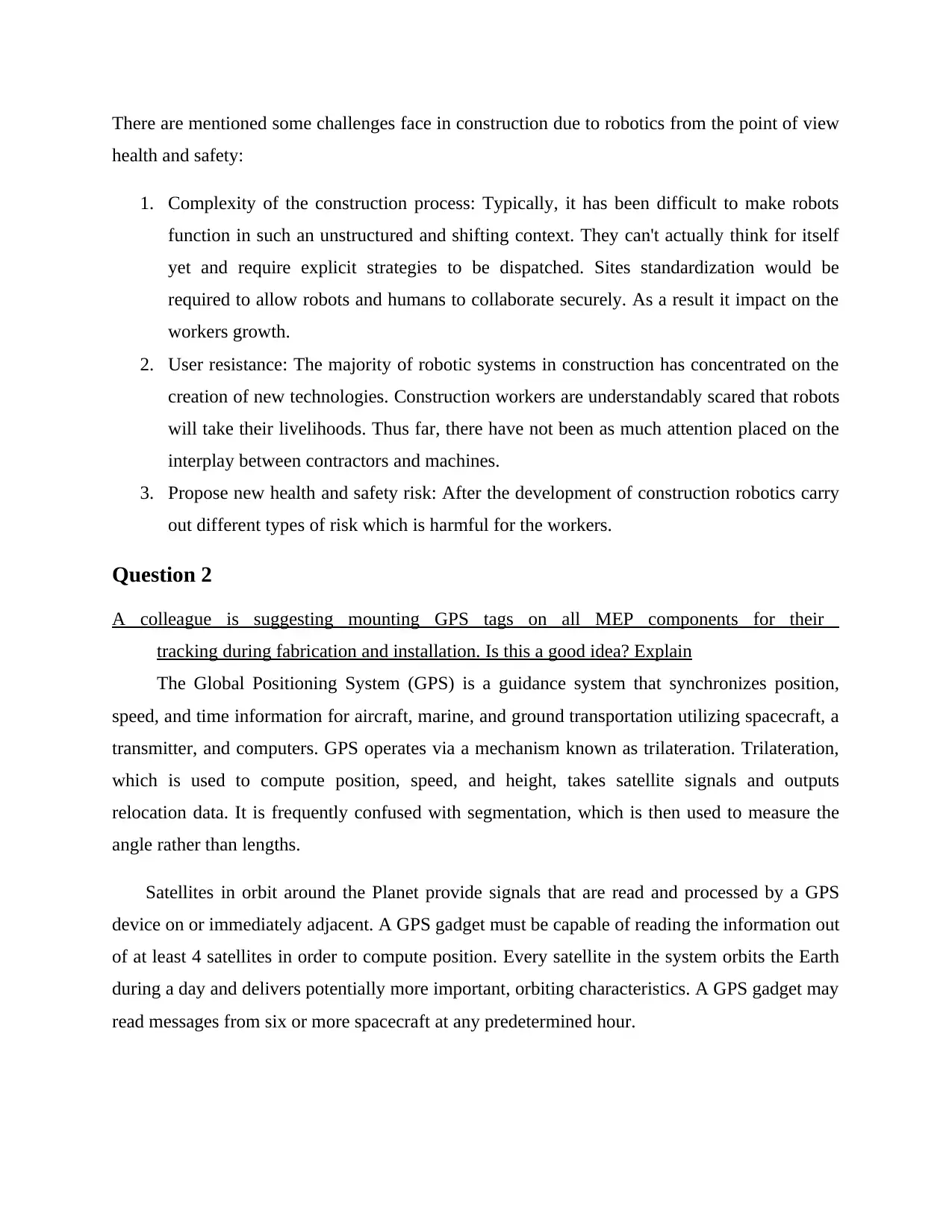
There are mentioned some challenges face in construction due to robotics from the point of view
health and safety:
1. Complexity of the construction process: Typically, it has been difficult to make robots
function in such an unstructured and shifting context. They can't actually think for itself
yet and require explicit strategies to be dispatched. Sites standardization would be
required to allow robots and humans to collaborate securely. As a result it impact on the
workers growth.
2. User resistance: The majority of robotic systems in construction has concentrated on the
creation of new technologies. Construction workers are understandably scared that robots
will take their livelihoods. Thus far, there have not been as much attention placed on the
interplay between contractors and machines.
3. Propose new health and safety risk: After the development of construction robotics carry
out different types of risk which is harmful for the workers.
Question 2
A colleague is suggesting mounting GPS tags on all MEP components for their
tracking during fabrication and installation. Is this a good idea? Explain
The Global Positioning System (GPS) is a guidance system that synchronizes position,
speed, and time information for aircraft, marine, and ground transportation utilizing spacecraft, a
transmitter, and computers. GPS operates via a mechanism known as trilateration. Trilateration,
which is used to compute position, speed, and height, takes satellite signals and outputs
relocation data. It is frequently confused with segmentation, which is then used to measure the
angle rather than lengths.
Satellites in orbit around the Planet provide signals that are read and processed by a GPS
device on or immediately adjacent. A GPS gadget must be capable of reading the information out
of at least 4 satellites in order to compute position. Every satellite in the system orbits the Earth
during a day and delivers potentially more important, orbiting characteristics. A GPS gadget may
read messages from six or more spacecraft at any predetermined hour.
health and safety:
1. Complexity of the construction process: Typically, it has been difficult to make robots
function in such an unstructured and shifting context. They can't actually think for itself
yet and require explicit strategies to be dispatched. Sites standardization would be
required to allow robots and humans to collaborate securely. As a result it impact on the
workers growth.
2. User resistance: The majority of robotic systems in construction has concentrated on the
creation of new technologies. Construction workers are understandably scared that robots
will take their livelihoods. Thus far, there have not been as much attention placed on the
interplay between contractors and machines.
3. Propose new health and safety risk: After the development of construction robotics carry
out different types of risk which is harmful for the workers.
Question 2
A colleague is suggesting mounting GPS tags on all MEP components for their
tracking during fabrication and installation. Is this a good idea? Explain
The Global Positioning System (GPS) is a guidance system that synchronizes position,
speed, and time information for aircraft, marine, and ground transportation utilizing spacecraft, a
transmitter, and computers. GPS operates via a mechanism known as trilateration. Trilateration,
which is used to compute position, speed, and height, takes satellite signals and outputs
relocation data. It is frequently confused with segmentation, which is then used to measure the
angle rather than lengths.
Satellites in orbit around the Planet provide signals that are read and processed by a GPS
device on or immediately adjacent. A GPS gadget must be capable of reading the information out
of at least 4 satellites in order to compute position. Every satellite in the system orbits the Earth
during a day and delivers potentially more important, orbiting characteristics. A GPS gadget may
read messages from six or more spacecraft at any predetermined hour.
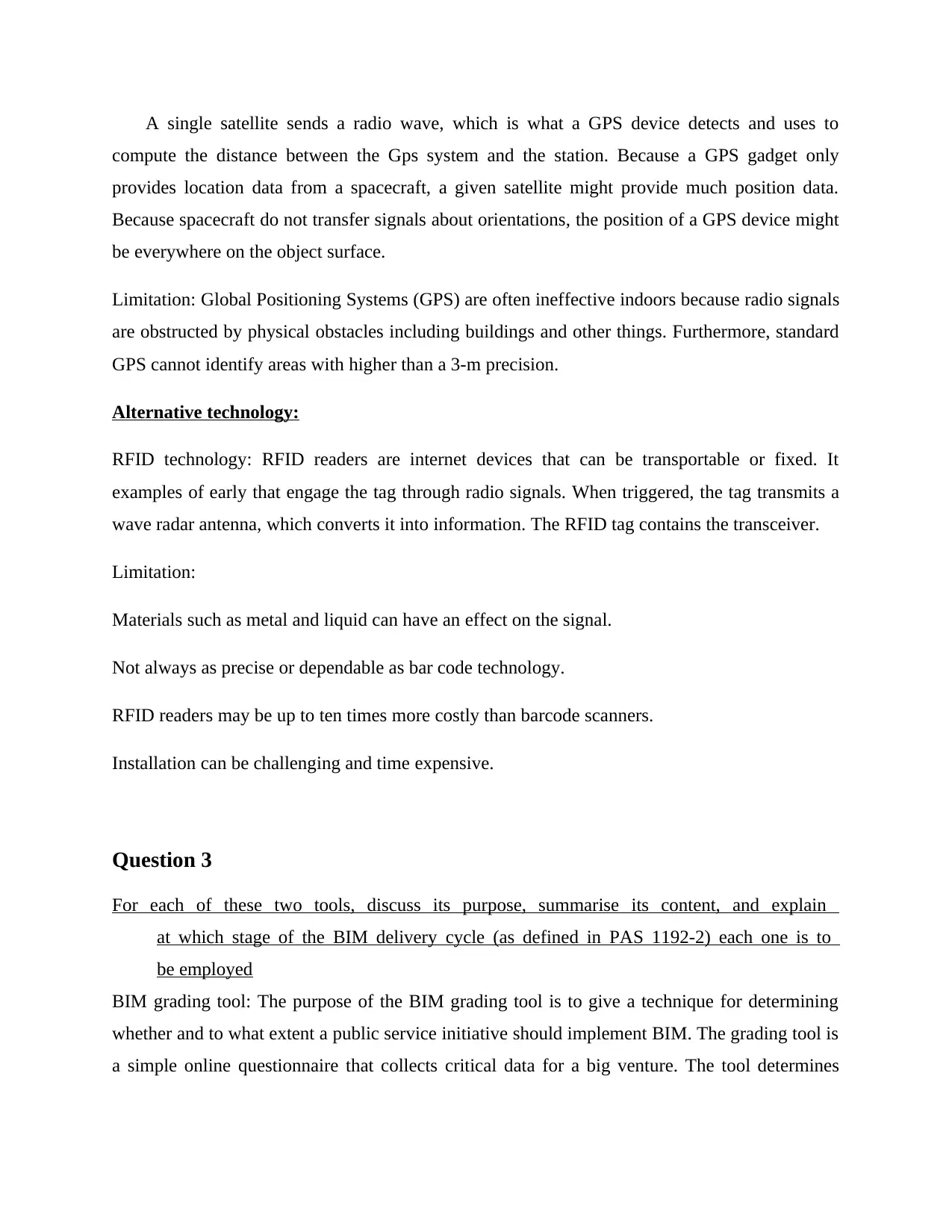
A single satellite sends a radio wave, which is what a GPS device detects and uses to
compute the distance between the Gps system and the station. Because a GPS gadget only
provides location data from a spacecraft, a given satellite might provide much position data.
Because spacecraft do not transfer signals about orientations, the position of a GPS device might
be everywhere on the object surface.
Limitation: Global Positioning Systems (GPS) are often ineffective indoors because radio signals
are obstructed by physical obstacles including buildings and other things. Furthermore, standard
GPS cannot identify areas with higher than a 3-m precision.
Alternative technology:
RFID technology: RFID readers are internet devices that can be transportable or fixed. It
examples of early that engage the tag through radio signals. When triggered, the tag transmits a
wave radar antenna, which converts it into information. The RFID tag contains the transceiver.
Limitation:
Materials such as metal and liquid can have an effect on the signal.
Not always as precise or dependable as bar code technology.
RFID readers may be up to ten times more costly than barcode scanners.
Installation can be challenging and time expensive.
Question 3
For each of these two tools, discuss its purpose, summarise its content, and explain
at which stage of the BIM delivery cycle (as defined in PAS 1192-2) each one is to
be employed
BIM grading tool: The purpose of the BIM grading tool is to give a technique for determining
whether and to what extent a public service initiative should implement BIM. The grading tool is
a simple online questionnaire that collects critical data for a big venture. The tool determines
compute the distance between the Gps system and the station. Because a GPS gadget only
provides location data from a spacecraft, a given satellite might provide much position data.
Because spacecraft do not transfer signals about orientations, the position of a GPS device might
be everywhere on the object surface.
Limitation: Global Positioning Systems (GPS) are often ineffective indoors because radio signals
are obstructed by physical obstacles including buildings and other things. Furthermore, standard
GPS cannot identify areas with higher than a 3-m precision.
Alternative technology:
RFID technology: RFID readers are internet devices that can be transportable or fixed. It
examples of early that engage the tag through radio signals. When triggered, the tag transmits a
wave radar antenna, which converts it into information. The RFID tag contains the transceiver.
Limitation:
Materials such as metal and liquid can have an effect on the signal.
Not always as precise or dependable as bar code technology.
RFID readers may be up to ten times more costly than barcode scanners.
Installation can be challenging and time expensive.
Question 3
For each of these two tools, discuss its purpose, summarise its content, and explain
at which stage of the BIM delivery cycle (as defined in PAS 1192-2) each one is to
be employed
BIM grading tool: The purpose of the BIM grading tool is to give a technique for determining
whether and to what extent a public service initiative should implement BIM. The grading tool is
a simple online questionnaire that collects critical data for a big venture. The tool determines
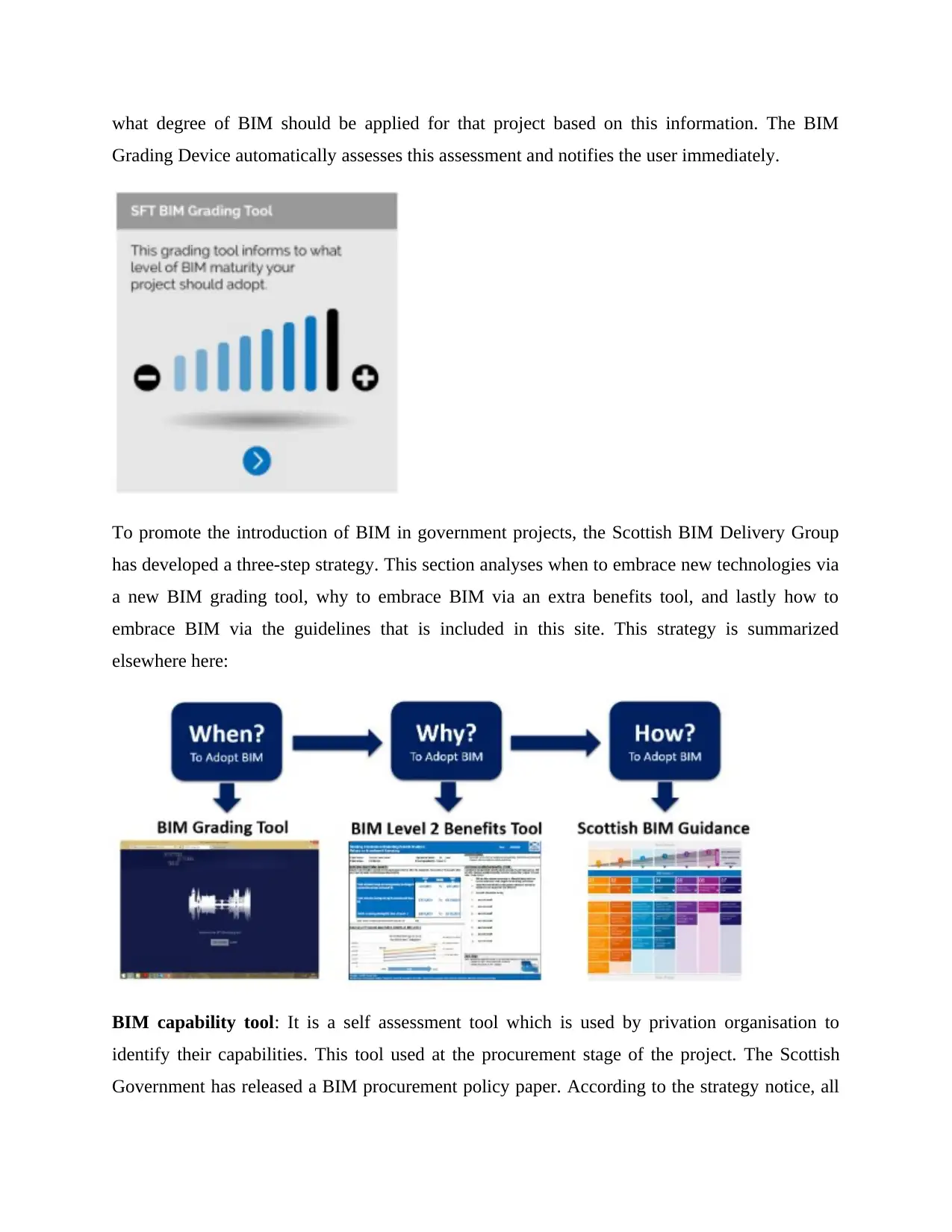
what degree of BIM should be applied for that project based on this information. The BIM
Grading Device automatically assesses this assessment and notifies the user immediately.
To promote the introduction of BIM in government projects, the Scottish BIM Delivery Group
has developed a three-step strategy. This section analyses when to embrace new technologies via
a new BIM grading tool, why to embrace BIM via an extra benefits tool, and lastly how to
embrace BIM via the guidelines that is included in this site. This strategy is summarized
elsewhere here:
BIM capability tool: It is a self assessment tool which is used by privation organisation to
identify their capabilities. This tool used at the procurement stage of the project. The Scottish
Government has released a BIM procurement policy paper. According to the strategy notice, all
Grading Device automatically assesses this assessment and notifies the user immediately.
To promote the introduction of BIM in government projects, the Scottish BIM Delivery Group
has developed a three-step strategy. This section analyses when to embrace new technologies via
a new BIM grading tool, why to embrace BIM via an extra benefits tool, and lastly how to
embrace BIM via the guidelines that is included in this site. This strategy is summarized
elsewhere here:
BIM capability tool: It is a self assessment tool which is used by privation organisation to
identify their capabilities. This tool used at the procurement stage of the project. The Scottish
Government has released a BIM procurement policy paper. According to the strategy notice, all
Paraphrase This Document
Need a fresh take? Get an instant paraphrase of this document with our AI Paraphraser
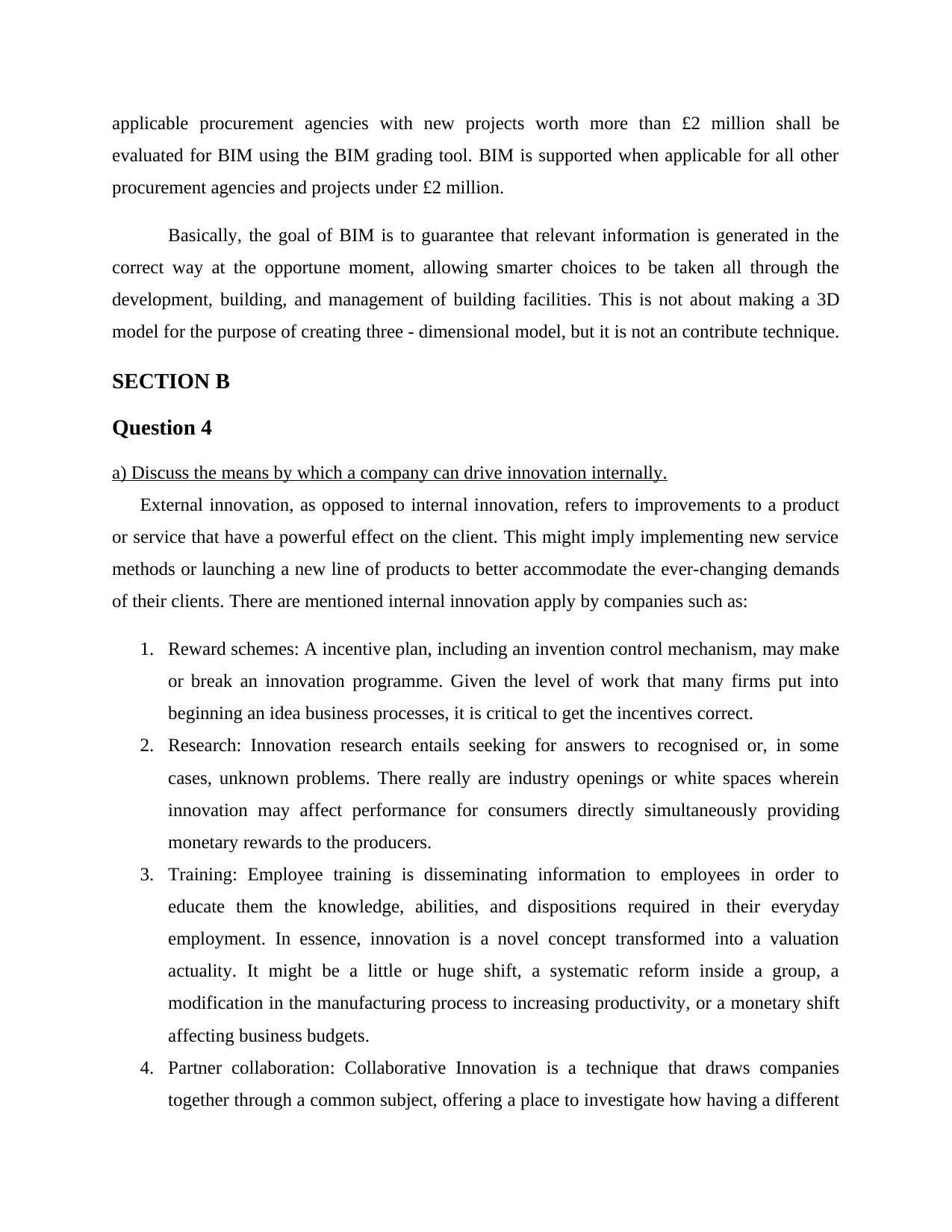
applicable procurement agencies with new projects worth more than £2 million shall be
evaluated for BIM using the BIM grading tool. BIM is supported when applicable for all other
procurement agencies and projects under £2 million.
Basically, the goal of BIM is to guarantee that relevant information is generated in the
correct way at the opportune moment, allowing smarter choices to be taken all through the
development, building, and management of building facilities. This is not about making a 3D
model for the purpose of creating three - dimensional model, but it is not an contribute technique.
SECTION B
Question 4
a) Discuss the means by which a company can drive innovation internally.
External innovation, as opposed to internal innovation, refers to improvements to a product
or service that have a powerful effect on the client. This might imply implementing new service
methods or launching a new line of products to better accommodate the ever-changing demands
of their clients. There are mentioned internal innovation apply by companies such as:
1. Reward schemes: A incentive plan, including an invention control mechanism, may make
or break an innovation programme. Given the level of work that many firms put into
beginning an idea business processes, it is critical to get the incentives correct.
2. Research: Innovation research entails seeking for answers to recognised or, in some
cases, unknown problems. There really are industry openings or white spaces wherein
innovation may affect performance for consumers directly simultaneously providing
monetary rewards to the producers.
3. Training: Employee training is disseminating information to employees in order to
educate them the knowledge, abilities, and dispositions required in their everyday
employment. In essence, innovation is a novel concept transformed into a valuation
actuality. It might be a little or huge shift, a systematic reform inside a group, a
modification in the manufacturing process to increasing productivity, or a monetary shift
affecting business budgets.
4. Partner collaboration: Collaborative Innovation is a technique that draws companies
together through a common subject, offering a place to investigate how having a different
evaluated for BIM using the BIM grading tool. BIM is supported when applicable for all other
procurement agencies and projects under £2 million.
Basically, the goal of BIM is to guarantee that relevant information is generated in the
correct way at the opportune moment, allowing smarter choices to be taken all through the
development, building, and management of building facilities. This is not about making a 3D
model for the purpose of creating three - dimensional model, but it is not an contribute technique.
SECTION B
Question 4
a) Discuss the means by which a company can drive innovation internally.
External innovation, as opposed to internal innovation, refers to improvements to a product
or service that have a powerful effect on the client. This might imply implementing new service
methods or launching a new line of products to better accommodate the ever-changing demands
of their clients. There are mentioned internal innovation apply by companies such as:
1. Reward schemes: A incentive plan, including an invention control mechanism, may make
or break an innovation programme. Given the level of work that many firms put into
beginning an idea business processes, it is critical to get the incentives correct.
2. Research: Innovation research entails seeking for answers to recognised or, in some
cases, unknown problems. There really are industry openings or white spaces wherein
innovation may affect performance for consumers directly simultaneously providing
monetary rewards to the producers.
3. Training: Employee training is disseminating information to employees in order to
educate them the knowledge, abilities, and dispositions required in their everyday
employment. In essence, innovation is a novel concept transformed into a valuation
actuality. It might be a little or huge shift, a systematic reform inside a group, a
modification in the manufacturing process to increasing productivity, or a monetary shift
affecting business budgets.
4. Partner collaboration: Collaborative Innovation is a technique that draws companies
together through a common subject, offering a place to investigate how having a different
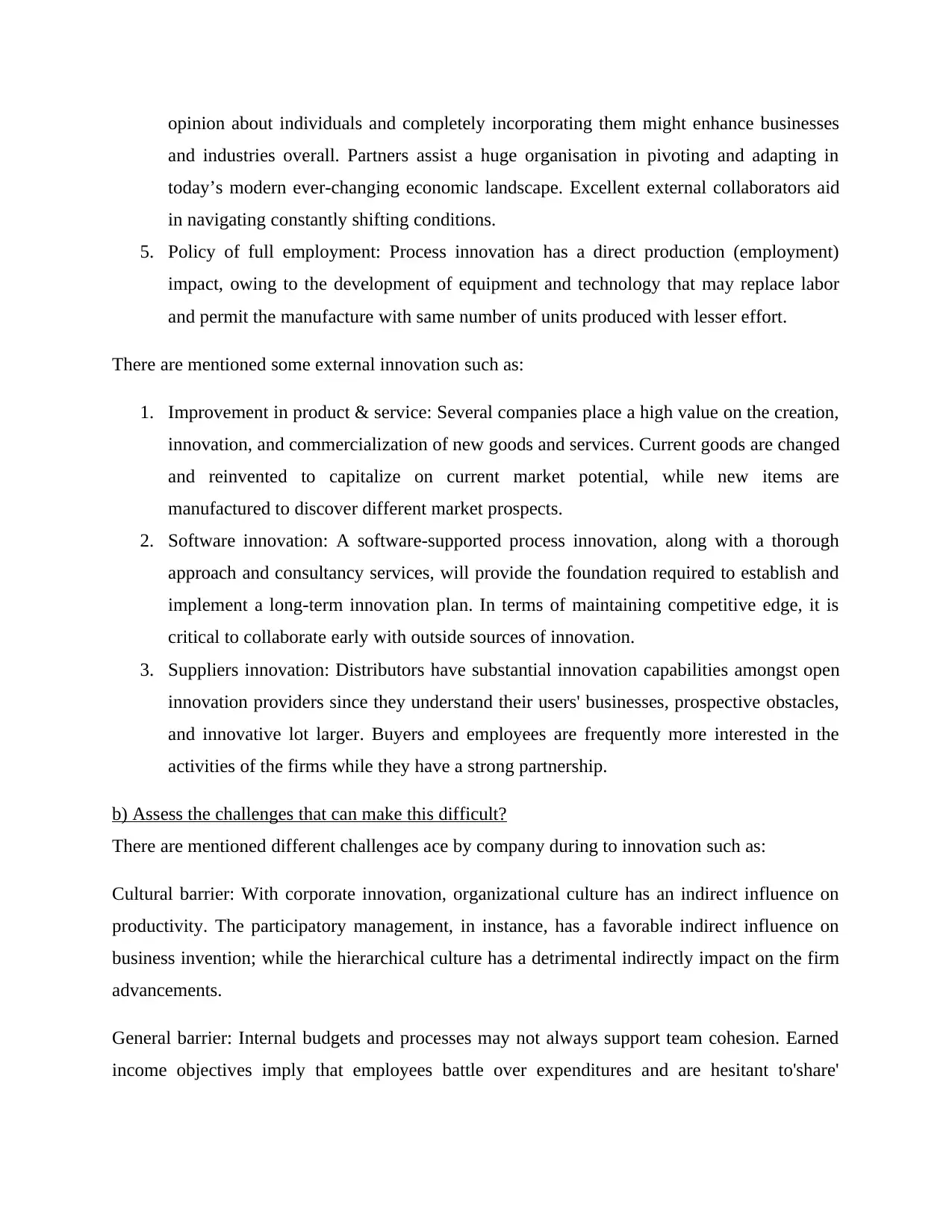
opinion about individuals and completely incorporating them might enhance businesses
and industries overall. Partners assist a huge organisation in pivoting and adapting in
today’s modern ever-changing economic landscape. Excellent external collaborators aid
in navigating constantly shifting conditions.
5. Policy of full employment: Process innovation has a direct production (employment)
impact, owing to the development of equipment and technology that may replace labor
and permit the manufacture with same number of units produced with lesser effort.
There are mentioned some external innovation such as:
1. Improvement in product & service: Several companies place a high value on the creation,
innovation, and commercialization of new goods and services. Current goods are changed
and reinvented to capitalize on current market potential, while new items are
manufactured to discover different market prospects.
2. Software innovation: A software-supported process innovation, along with a thorough
approach and consultancy services, will provide the foundation required to establish and
implement a long-term innovation plan. In terms of maintaining competitive edge, it is
critical to collaborate early with outside sources of innovation.
3. Suppliers innovation: Distributors have substantial innovation capabilities amongst open
innovation providers since they understand their users' businesses, prospective obstacles,
and innovative lot larger. Buyers and employees are frequently more interested in the
activities of the firms while they have a strong partnership.
b) Assess the challenges that can make this difficult?
There are mentioned different challenges ace by company during to innovation such as:
Cultural barrier: With corporate innovation, organizational culture has an indirect influence on
productivity. The participatory management, in instance, has a favorable indirect influence on
business invention; while the hierarchical culture has a detrimental indirectly impact on the firm
advancements.
General barrier: Internal budgets and processes may not always support team cohesion. Earned
income objectives imply that employees battle over expenditures and are hesitant to'share'
and industries overall. Partners assist a huge organisation in pivoting and adapting in
today’s modern ever-changing economic landscape. Excellent external collaborators aid
in navigating constantly shifting conditions.
5. Policy of full employment: Process innovation has a direct production (employment)
impact, owing to the development of equipment and technology that may replace labor
and permit the manufacture with same number of units produced with lesser effort.
There are mentioned some external innovation such as:
1. Improvement in product & service: Several companies place a high value on the creation,
innovation, and commercialization of new goods and services. Current goods are changed
and reinvented to capitalize on current market potential, while new items are
manufactured to discover different market prospects.
2. Software innovation: A software-supported process innovation, along with a thorough
approach and consultancy services, will provide the foundation required to establish and
implement a long-term innovation plan. In terms of maintaining competitive edge, it is
critical to collaborate early with outside sources of innovation.
3. Suppliers innovation: Distributors have substantial innovation capabilities amongst open
innovation providers since they understand their users' businesses, prospective obstacles,
and innovative lot larger. Buyers and employees are frequently more interested in the
activities of the firms while they have a strong partnership.
b) Assess the challenges that can make this difficult?
There are mentioned different challenges ace by company during to innovation such as:
Cultural barrier: With corporate innovation, organizational culture has an indirect influence on
productivity. The participatory management, in instance, has a favorable indirect influence on
business invention; while the hierarchical culture has a detrimental indirectly impact on the firm
advancements.
General barrier: Internal budgets and processes may not always support team cohesion. Earned
income objectives imply that employees battle over expenditures and are hesitant to'share'
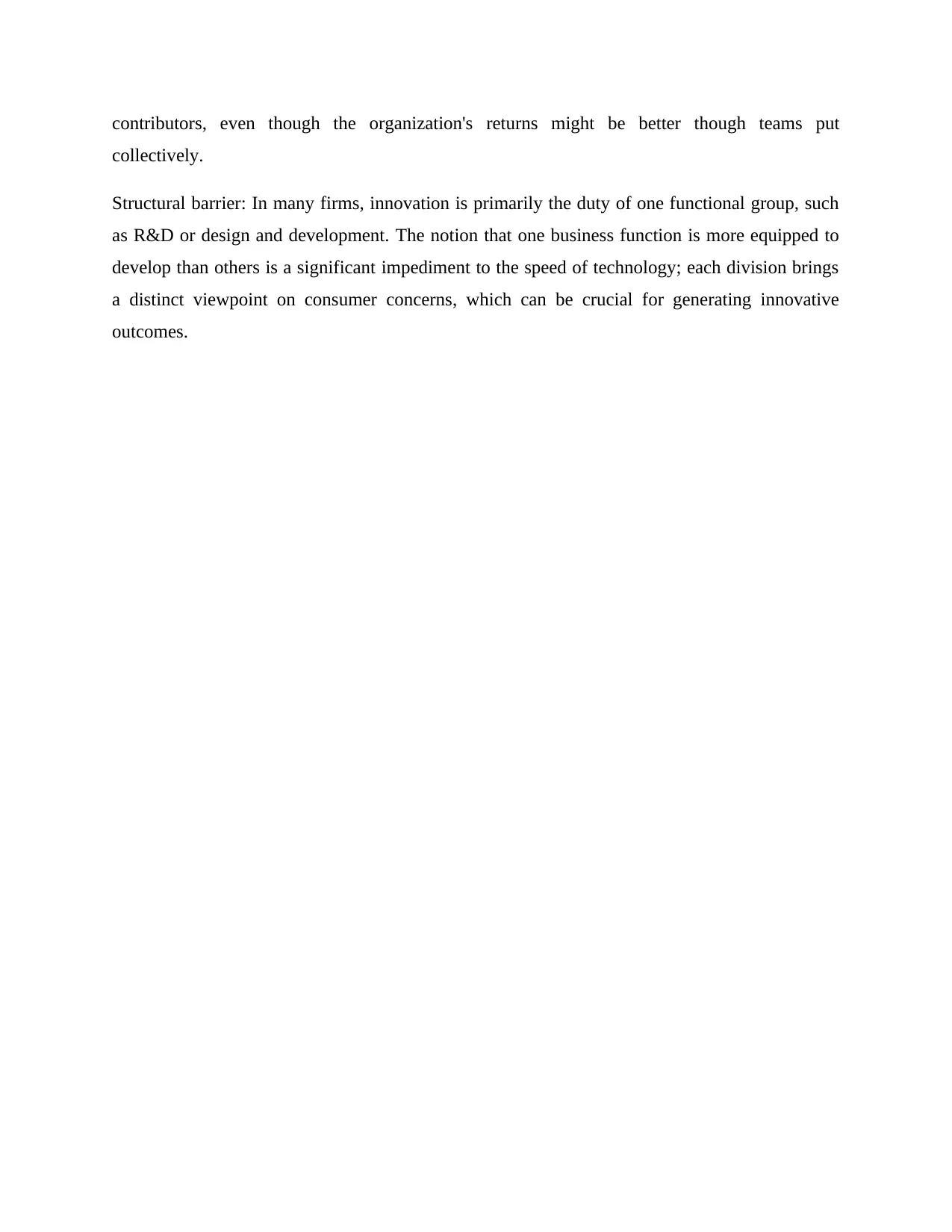
contributors, even though the organization's returns might be better though teams put
collectively.
Structural barrier: In many firms, innovation is primarily the duty of one functional group, such
as R&D or design and development. The notion that one business function is more equipped to
develop than others is a significant impediment to the speed of technology; each division brings
a distinct viewpoint on consumer concerns, which can be crucial for generating innovative
outcomes.
collectively.
Structural barrier: In many firms, innovation is primarily the duty of one functional group, such
as R&D or design and development. The notion that one business function is more equipped to
develop than others is a significant impediment to the speed of technology; each division brings
a distinct viewpoint on consumer concerns, which can be crucial for generating innovative
outcomes.
Secure Best Marks with AI Grader
Need help grading? Try our AI Grader for instant feedback on your assignments.
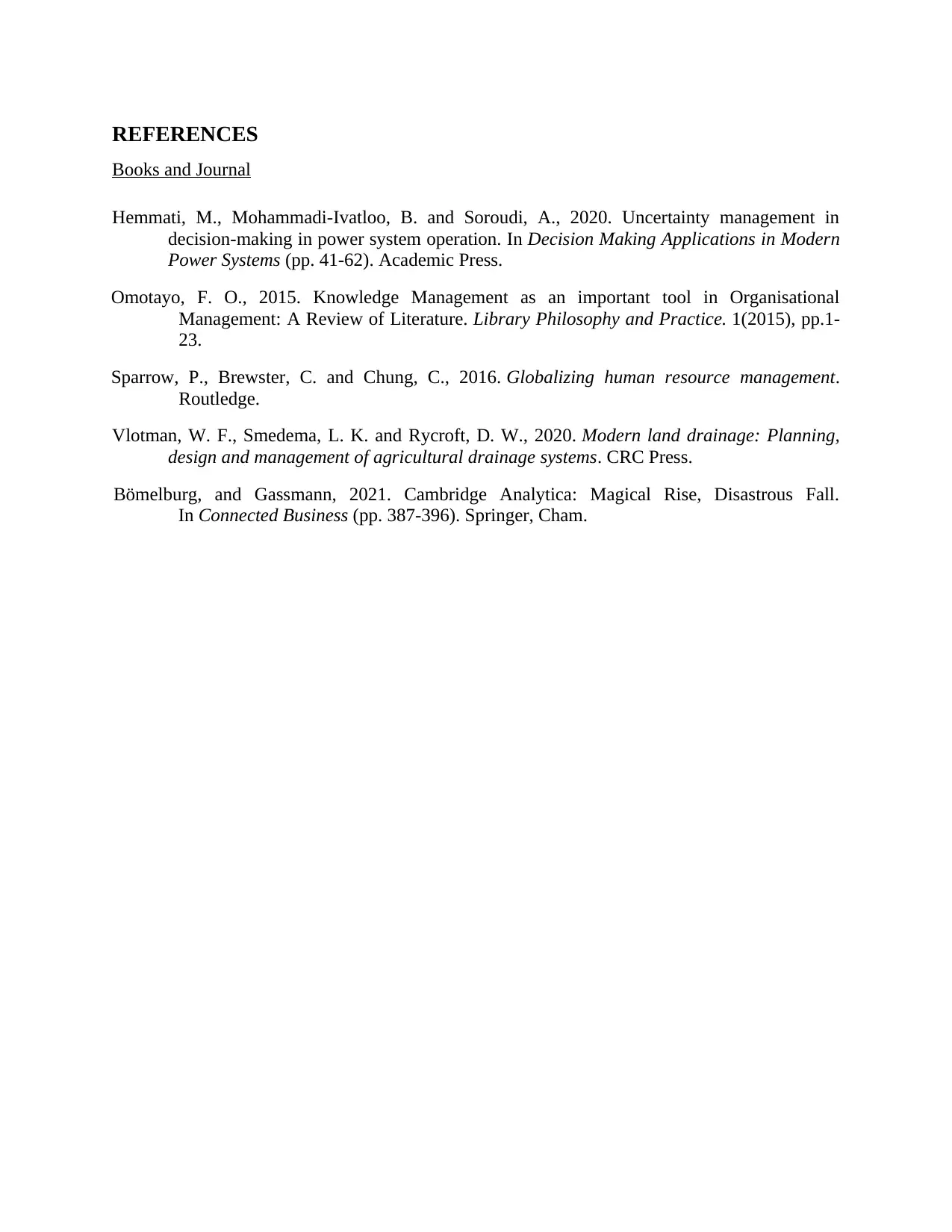
REFERENCES
Books and Journal
Hemmati, M., Mohammadi-Ivatloo, B. and Soroudi, A., 2020. Uncertainty management in
decision-making in power system operation. In Decision Making Applications in Modern
Power Systems (pp. 41-62). Academic Press.
Omotayo, F. O., 2015. Knowledge Management as an important tool in Organisational
Management: A Review of Literature. Library Philosophy and Practice. 1(2015), pp.1-
23.
Sparrow, P., Brewster, C. and Chung, C., 2016. Globalizing human resource management.
Routledge.
Vlotman, W. F., Smedema, L. K. and Rycroft, D. W., 2020. Modern land drainage: Planning,
design and management of agricultural drainage systems. CRC Press.
Bömelburg, and Gassmann, 2021. Cambridge Analytica: Magical Rise, Disastrous Fall.
In Connected Business (pp. 387-396). Springer, Cham.
Books and Journal
Hemmati, M., Mohammadi-Ivatloo, B. and Soroudi, A., 2020. Uncertainty management in
decision-making in power system operation. In Decision Making Applications in Modern
Power Systems (pp. 41-62). Academic Press.
Omotayo, F. O., 2015. Knowledge Management as an important tool in Organisational
Management: A Review of Literature. Library Philosophy and Practice. 1(2015), pp.1-
23.
Sparrow, P., Brewster, C. and Chung, C., 2016. Globalizing human resource management.
Routledge.
Vlotman, W. F., Smedema, L. K. and Rycroft, D. W., 2020. Modern land drainage: Planning,
design and management of agricultural drainage systems. CRC Press.
Bömelburg, and Gassmann, 2021. Cambridge Analytica: Magical Rise, Disastrous Fall.
In Connected Business (pp. 387-396). Springer, Cham.
1 out of 11
Related Documents
Your All-in-One AI-Powered Toolkit for Academic Success.
+13062052269
info@desklib.com
Available 24*7 on WhatsApp / Email
![[object Object]](/_next/static/media/star-bottom.7253800d.svg)
Unlock your academic potential
© 2024 | Zucol Services PVT LTD | All rights reserved.





